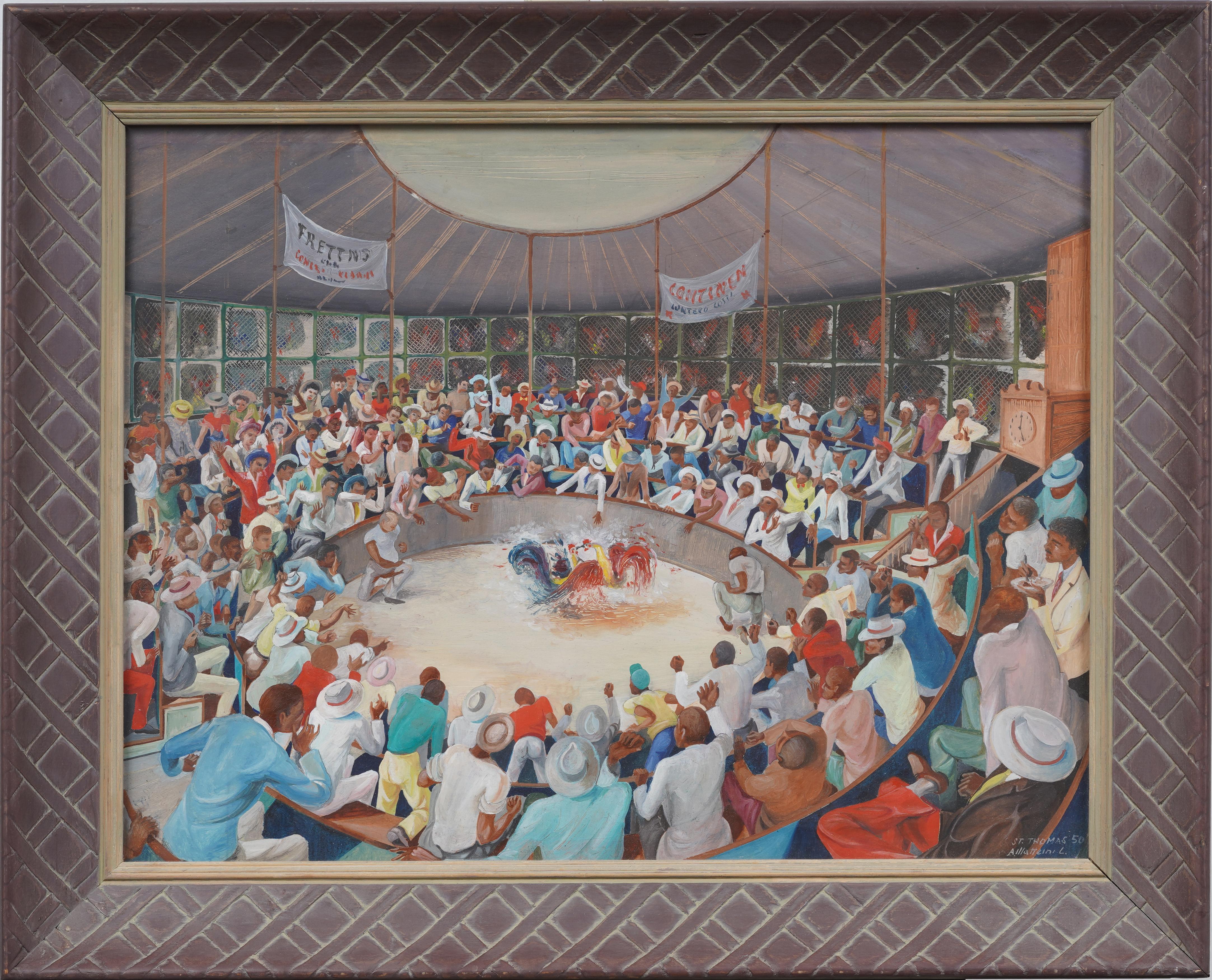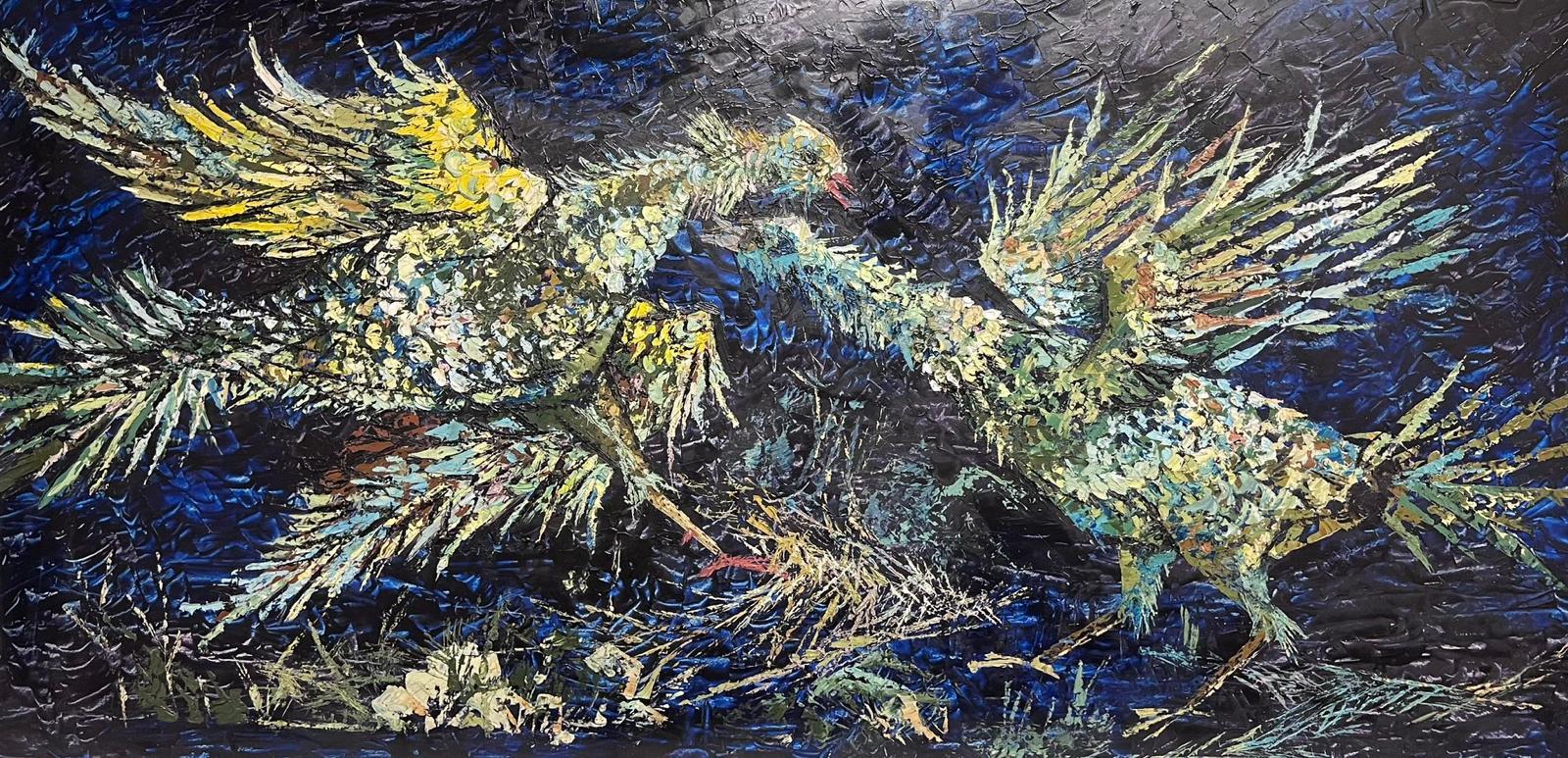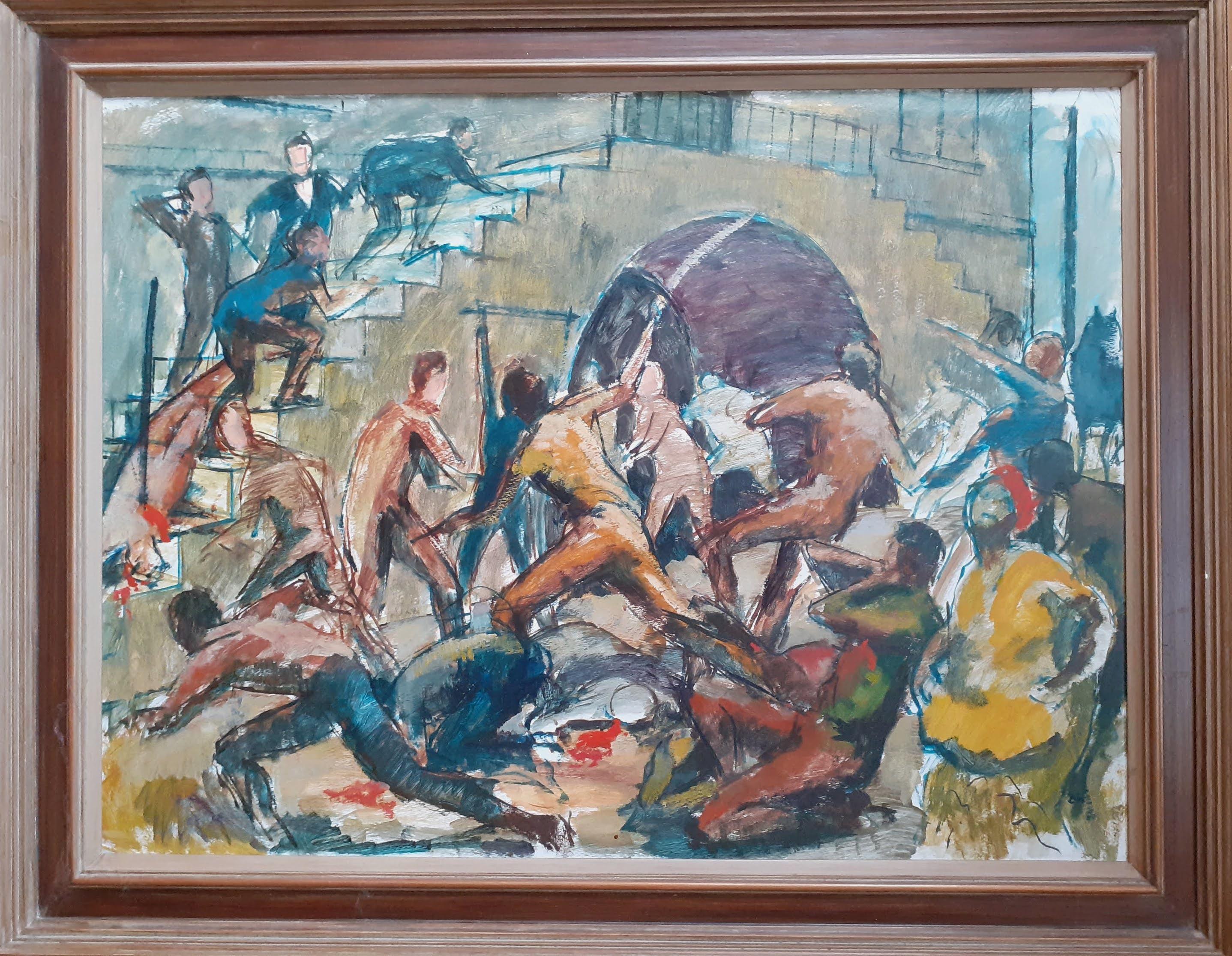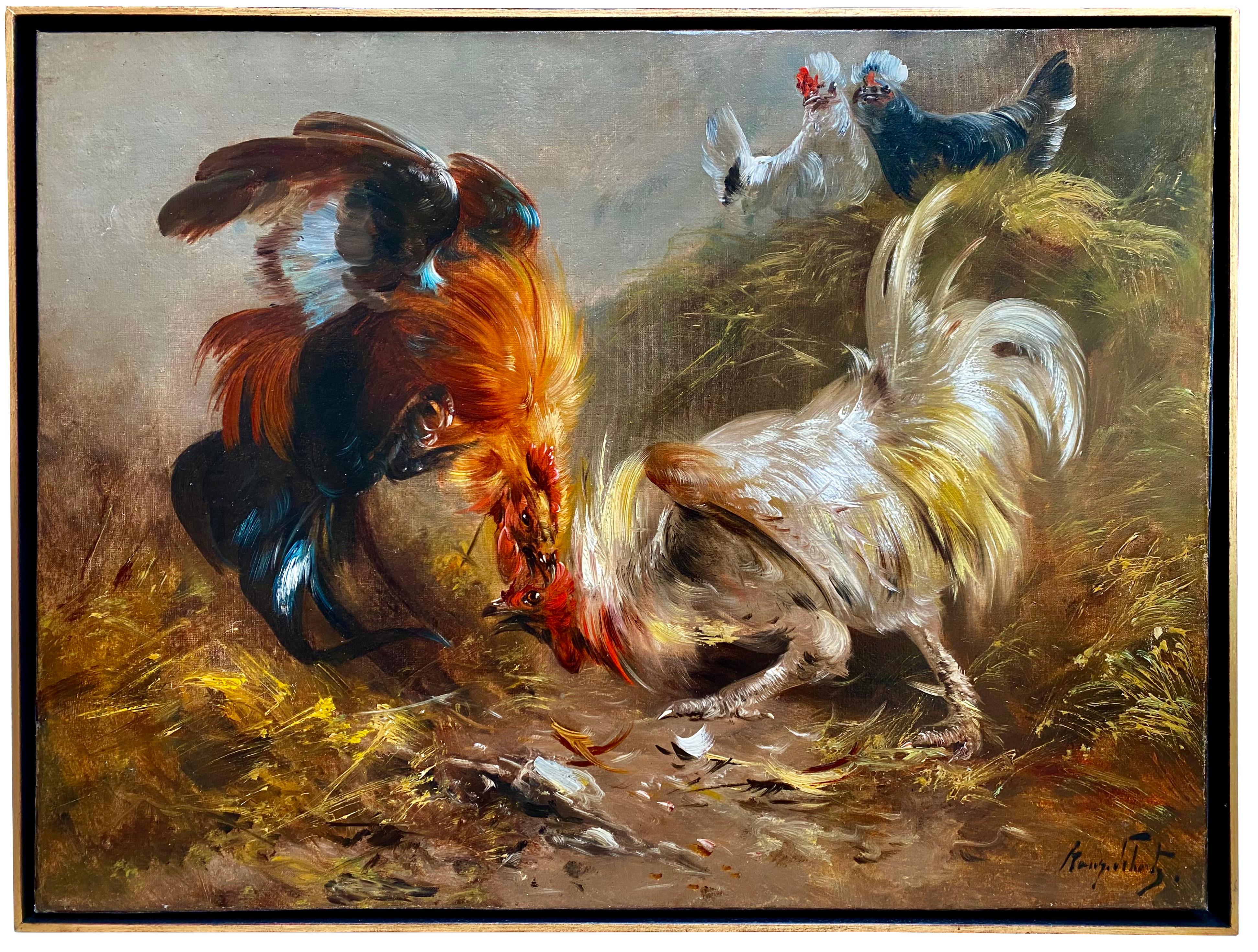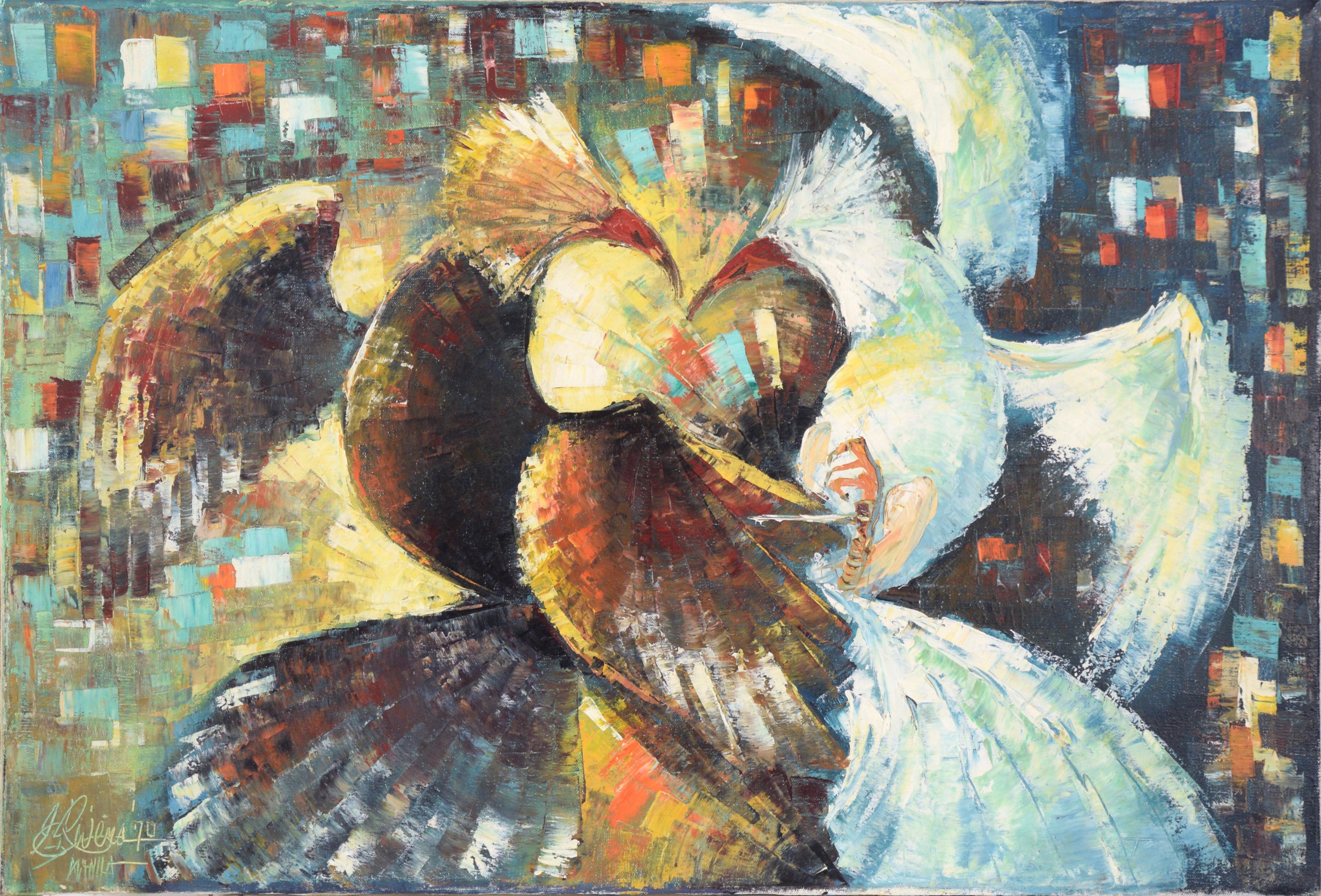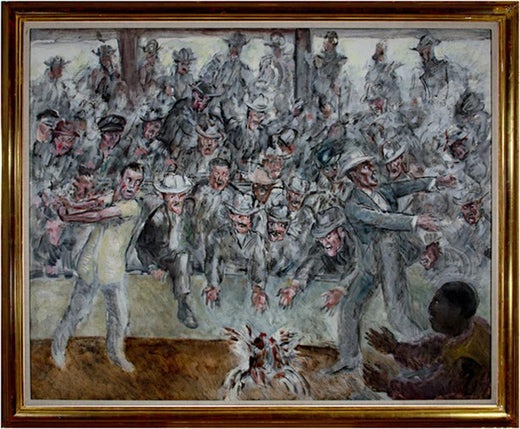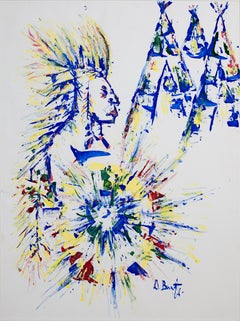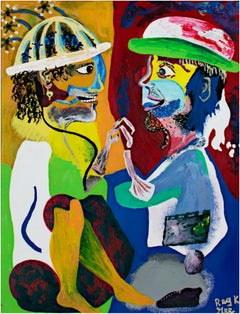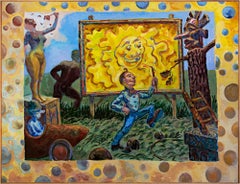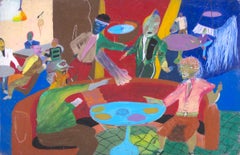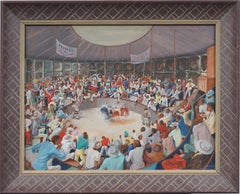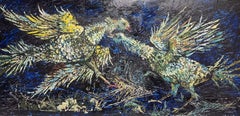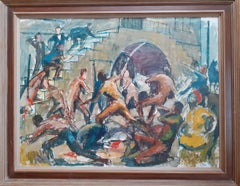Artículos similares a 'Cock Fight in Cuba' original Regionalist painting signed by John Steuart Curry
¿Quieres más imágenes o vídeos?
Solicita imágenes o vídeos adicionales al vendedor
1 de 10
John Steuart Curry'Cock Fight in Cuba' original Regionalist painting signed by John Steuart Curry1946
1946
947.317,25 €
Acerca del artículo
John Steuart Curry
"Cockfight in Cuba," 1946
oil on canvas
Image: 38.25 x 46.25 in
Frame: 43.75 x 51.5 in
Signed on reverse with initials JSC on lower right stretcher bar
John Steuart Curry (1897-1946), is best-known as one of the American Regionalist artists active during the Great Depression through the World War II era. The Regionalists (including artists Grant Wood and Thomas Hart Benton) distinguished themselves from the abstract art scene during the first part of the Twentieth century by painting typically American subject matter, although Curry’s themes were hardly limited to farms. While born in Kansas on his family’s farm, Curry went on to study art in Chicago, Paris and New York as a young man. In Paris, he was exposed to the work of some of the Old Masters, particularly Rubens, Delacroix, and David. Like these artists, Curry’s major themes and subject matter were the great struggles of life.
One of Curry’s paintings that exemplify this theme of human struggle is Cock Fight in Cuba, which was completed in 1946, the year of his death. Curry spent a little over a month in Cuba in early 1946 in preparation for an advertising campaign for National City Bank, and undoubtedly sketched this scene, as was his method, while traveling in the country. The painting depicts a crowd of suited men in fedoras cheering on two fighting cocks in the foreground. While the men in the crowd gesticulate wildly behind a low wall indicating the barrier of the ring, three men are in the foreground of the painting, inside the ring with the roosters. The two on either side of the fighting animals have their arms extended out as if to hold the crowd back. The third man, in the lower right corner of the painting, is African and his hands reach towards the birds as if to save them, which has the effect of directing the viewer’s gaze at the action. Curry uses the lines created by the arm gestures of the men to bring focus on the drama of the fighting animals.
The colors with which Curry has painted Cockfight in Cuba are also a way that he directs the viewer’s attention and sets a mood for the piece. In the background of the painting, the crowd of men is painted en grisaille, or in shades of gray, which makes the dark brown skin of the African man in the foreground stand out. The bright red of the birds’ cockles and the blood on their feathers are about the only spots of color in the painting. This bit of contrast is very effective in drawing our gaze to the birds, who are themselves nearly a blur of flapping wings. Curry’s painting style in Cockfight is brushy, as if the way he applied the paint was also part of the rather frenzied, dramatic scene. This fact, along with the predominant use of gray in the background, probably led to the incorrect belief that this painting was unfinished at the time of Curry’s death, but we know it is a completed work because the artist’s conception is fully realized. The painting is also signed on reverse with the initials JSC on the lower right stretcher bar. More evidence of the finality of the painting can be found in the fact that preliminary drawings exist for Cockfight in Cuba that are in the collection of the Springfield Museum of Art in Missouri. The composition of the final painting directly reflects what the artist had worked out in the initial drawings.
The subject of fighting animals is one Curry used throughout his career, and most likely grew out of his experiences among animals in his youth on his parents’ farm. Curry witnessed the drama of life and death firsthand and this became to him a great allegory for human struggles. The image of two animals, even two of the same species, fighting to the death, was a symbol of humankind’s simultaneous innate violence and vulnerability.
The more specific symbolism in Cockfight in Cuba, however, is the comparison made by the artist between animal violence and the racial violence of Curry’s time. The horror of seeing the cocks fight to the death is a metaphor for white oppression of and the violence towards blacks in the United States at that time. It was during this era that highly publicized lynching was occurring in the South and America saw resurgence in the Ku Klux Klan. This painting is important because Curry has revealed for the viewer his own moral beliefs. Curry’s social and political views were progressive – he was a member of the National Urban League and was a civil rights activist, whose friends included Wisconsin Governor Robert Lafollette (founder of the Progressive party) and Lloyd Garrison, the famously liberal Dean of the University of Wisconsin Law School while Curry was employed at the University as artist-in-residence. Curry had made political statements in his paintings many times before and some of his most important works centered on subject matter from the African American experience during the early part of the Twentieth century. Examples include The Fugitive (lithograph, 1934-36) and Manhunt (lithograph, 1934), which are both about lynching, and what is arguably Curry’s most important work on this theme, The Freeing of the Slaves (mural, 1942, University of Wisconsin Law Library).
In Cockfight in Cuba, Curry was able to express deeply held beliefs on a subject that was important to him and many other people of his time. Curry believed that, above all, art should have a social significance to the viewer, and the best artists were those that presented current social or ethical issues in their work. By that standard, he would certainly have been pleased with this painting, which uses the event of the cockfight to create a spectacle analogous to horror of a lynch mob. This painting is a wonderful demonstration of how John Steuart Curry used scenes that he observed from life and re-interpreted them on canvas to express a greater moral meaning.
Essay by Monet C. Haskins and David J. Barnett
- Creador:John Steuart Curry (1897-1946, Americana)
- Año de creación:1946
- Dimensiones:Altura: 111,13 cm (43,75 in)Anchura: 130,81 cm (51,5 in)
- Medio:
- Movimiento y estilo:
- Época:
- Estado:
- Ubicación de la galería:Milwaukee, WI
- Número de referencia:Vendedor: 12845g1stDibs: LU60535197151
John Steuart Curry
Nacido en Dunavant, Kansas, el 14 de noviembre de 1897, John Steuart Curry se convirtió en el miembro más joven del famoso "trío Benton-Wood-Curry" de Pintores Regionales del movimiento de la Escena Americana de principios del siglo XX. Ganó reputación nacional por sus escenas rurales de Kansas. El artista se centraba en personas que tenían los pies en la tierra, hablaban claro y eran autosuficientes, y que se ganaban la vida mediante un duro trabajo físico. Curry ejecutó murales que tratan de la colonización de tierras y la justicia racial, y sus obras que reflejan estos temas se encuentran en el edificio del Capitolio de Kansas, la Universidad de Wisconsin, el Departamento del Interior y el Departamento de Justicia de Estados Unidos. El artista dejó el instituto y asistió al Instituto de Arte y Escuela de Diseño de Kansas City. Se trasladó al Instituto de Arte de Chicago. Curry se casó con Clara Derrick en 1923. Estudió en París en 1927. No le impresionaban los pintores modernistas estadounidenses, muchos de los cuales adoptaban los "ismos" de los artistas contemporáneos franceses. Curry estaba decidido a pintar temas americanos sin modelos europeos y a celebrar el patriotismo, el orgullo regional y al hombre corriente. He se estableció en Westport, Connecticut. En 1928 pintó Bautismo en Kansas. El cuadro fue anunciado a escala nacional como obra de un nuevo género estadounidense. Se expuso en la bienal de la Galería de Arte Corcoran, donde fue aclamada por la crítica. En 1931, Gertrude Vanderbilt Whitney la compró para su museo. Tornado sobre Kansas se inauguró en 1929, antes del crack bursátil, y proporcionó a la ciudad el tema romántico del hombre contra la naturaleza. En 1933, recibió el segundo premio en la Exposición Internacional Carnegie. En 1930, realizó su primera exposición individual en el Whitney Studio Club. Su obra de los años 30 contiene temas sobre el trabajo, la familia y la tierra, demostrando la paz, la lucha y la perseverancia que Curry creía que eran la esencia de la vida estadounidense. En 1934 se casó con Kathleen Shepard. El gobierno de Estados Unidos le seleccionó para pintar murales para el Departamento de Justicia y el Departamento de Interior. En 1936 fue nombrado Artista Residente en la Facultad de Agricultura de la Universidad de Wisconsin. Fue miembro de la Liga de Estudiantes de Arte y ganó premios como: Premio de compra, North West Print Maker, quinta Exposición anual, 1933; segundo premio, Trigésimo primera Exposición Internacional, Instituto Carnegie, 1933; Gold Medal, PAFA, 1941; premio, Exposición Artistas para la Victoria, Museo Metropolitano de Arte, 1941. Entre las exposiciones se incluyen: "Una celebración de la América rural", 2007, Museo de Bellas Artes e Historia de Danville; "Imágenes colectivas: los cuadernos de bocetos de John Steuart Curry", 2002, Museo de Arte de Worcester; "Ilusiones del Edén: Visiones del corazón de Estados Unidos", 2000, Museo de Arte de Columbus; "The American Century: Arte y Cultura 1900-2000", Museo Whitney de Arte Americano; y "John Steuart Curry: Inventando el Medio Oeste", 1998, Museo Conmemorativo M.H. de Young. He murió en Madison, Wisconsin, en 1946.
Sobre el vendedor
4,9
Vendedor Platino
Vendedores premium con una calificación de +4,7 y tiempos de respuesta de 24 horas
Establecido en 1966
Vendedor de 1stDibs desde 2017
442 ventas en 1stDibs
Tiempo de respuesta usual: 3 horas
- EnvíoRecuperando presupuesto…Envío desde: Milwaukee, WI
- Política de devolución
Partes de esta página se han traducido automáticamente. 1stDibs no puede garantizar la exactitud de las traducciones. El inglés es el idioma predeterminado de este sitio web.
Garantía de autenticidad
En el improbable caso de que haya algún problema con la autenticidad de un artículo, ponte en contacto con nosotros en un plazo de 1 año para recibir un reembolso total. DetallesGarantía de devolución de dinero
Si tu artículo no es como se describe, sufre daños durante el transporte o no llega, ponte en contacto con nosotros en un plazo de 7 días para recibir un reembolso total. DetallesCancelación dentro de las 24 horas
Tienes un período de gracia de 24 horas para reconsiderar tu compra, sin preguntas.Vendedores profesionales aprobados
Nuestros vendedores de primera clase deben cumplir estrictos estándares de servicio para mantener la integridad de nuestros anuncios.Garantía de igualación de precios
Si encuentras que un vendedor publicó el mismo artículo por un precio menor en otro lado, igualaremos ese precio.Entrega global de confianza
Nuestra red de transporte de primera ofrece opciones de envío especializado en todo el mundo, que incluye envío personalizado.Más de este vendedor
Ver todo"Pow-Wow indio", pintura original al temple firmada por David Barnett
Por David Barnett
"Indian Pow-Wow" es una pintura original al temple, firmada en la parte inferior derecha. Presenta contornos azules gestuales, decorados en tonos amarillos, azules y verdes.
Medidas...
Categoría
Década de 1960, Contemporáneo, Pinturas figurativas
Materiales
Témpera
"Footwork at Random - Variation I, " Técnica mixta Acrílico firmado por Reginald Gee
Por Reginald K. Gee
"Juego de pies al azar - Variación I" es una pintura acrílica en técnica mixta sobre lienzo de Reginald K. Gee. El artista firmó la obra en la parte inferior derecha. Representa a do...
Categoría
Principios de los 2000, Contemporáneo, Pinturas figurativas
Materiales
Lienzo, Técnica mixta, Acrílico
"Artista en Heliópolis", acrílico sobre lienzo de Randall Berndt
Por Randall Berndt
"Artista en Heliópolis" es una pintura acrílica original de Randall Berndt. Representa a un artista saltarín con algunas otras figuras distorsionadas. "Heliópolis", en el título del ...
Categoría
Década de 1980, Pinturas figurativas
Materiales
Lienzo, Acrílico
"Lejos de sonidos familiares", dibujo al óleo y pastel firmado por Reginald K. Gee
Por Reginald K. Gee
"Lejos de los sonidos familiares" es un dibujo original al óleo sobre cartón de Reginald K. Gee. El artista firmó la pieza en el reverso. Representa varias figuras abstractas sentada...
Categoría
Década de 1980, Contemporáneo, Dibujos y acuarelas figurativos
Materiales
Pastel al óleo
"El Baile", óleo sobre yute firmado por Ernesto Gutiérrez
Por Ernesto Gutierrez (b.1941)
"El Baile" es una pintura original al óleo sobre yute de Ernesto Gutiérrez. El artista firmó la obra en la parte inferior derecha. Este cuadro representa a cinco figuras bailando y t...
Categoría
Principios de los 2000, Pinturas figurativas
Materiales
Óleo, Yute
"Salón", am Óleo sobre tabla firmado por Charles Damrow
Por Charles Damrow
"Saloon" es un óleo original sobre tabla firmado y fechado en la parte inferior izquierda por el artista Charles Damrow. Representa a dos vaqueros a caballo con pistolas apuntando a ...
Categoría
Década de 1970, Otro estilo de arte, Pinturas figurativas
Materiales
Óleo
También te puede gustar
Pintura antigua superdetallada de realismo social sobre la lucha de gallinas de St Thomas Tropical
Una escena de peleas de gallos, vívida y densamente poblada, pintada en 1950 y firmada Allatteini L., abajo a la derecha, con la inscripción Santo Tomás 50. Este óleo a gran escala c...
Categoría
Década de 1950, Moderno, Pinturas de interiores
Materiales
Óleo, Tablero
1960 Enorme óleo modernista La pelea de gallos
La pelea de gallos
Escuela Francesa, época de los años 60
óleo sobre tabla, enmarcado
enmarcado: 25 x 48,75 pulgadas
tablero: 24 x 48 pulgadas
procedencia: colección privada
estado: ...
Categoría
mediados del siglo XX, Moderno, Pinturas de animales
Materiales
Óleo
Enorme esclavitud tópica de la Historia Negra pintura Jamaica Morant Bay 1865 rebelión
Uprising - una enorme y Pintura increíblemente poderosa y actual del maestro jamaicano Barrington Watson (1931-2016).
Representa el 1865 Rebelión de Morant Bay, en la que los jama...
Categoría
Década de 1960, Realista, Pinturas figurativas
Materiales
Masonita, Óleo
Pelea de gallos" de Henry Schouten (Batavia, Indonesia 1857 - 1927 Bruselas)
Henry Schouten
Batavia, Indonesia 1857 - 1927 Bruselas
Pintor belga
Pelea de gallos
Una escena dinámica y vívida que capta a dos gallos en plena pelea con la pincelada fluida y lo...
Categoría
Fines del siglo XIX, Impresionista, Pinturas de animales
Materiales
Lienzo, Óleo
Pelea de gallos abstracta Filipinas 1970
Brillante y dinámica representación de dos pájaros luchando, del artista filipino JG Rivera (siglo XX). Salpicaduras de color rodean una floritura de plumas. En el centro de la compo...
Categoría
Década de 1970, Impresionista abstracto, Pinturas figurativas
Materiales
Lienzo, Óleo
Peleador Boxeo Woodstock Escena Americana WPA Era Mediados Siglo XX Realismo Social
Peleador Boxeo Woodstock Escena Americana WPA Era Mediados Siglo XX Social
John Ruggles (1907-1991)
Vista: 17 1/2 x 13 1/3 pulgadas.
Enmarcado: 22 x 18 pulgadas.
Óleo sobre tabla...
Categoría
Década de 1930, realista estadounidense, Dibujos y acuarelas figurativos
Materiales
Óleo, Tablero
